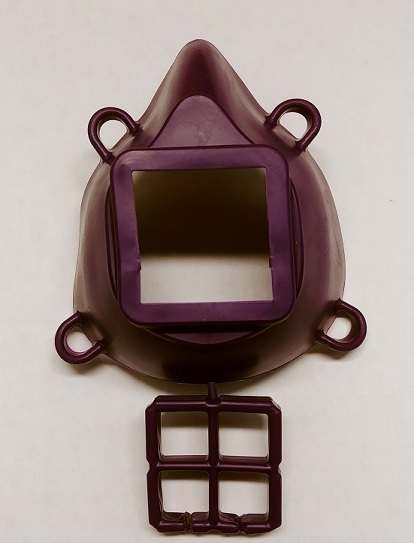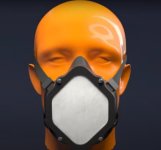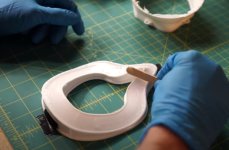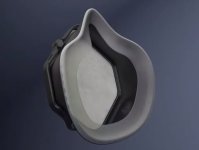I've been waiting to post because this is evolving rapidly, which is what happens when millions of people are reading about something and are given the opportunity to share any knowledge that might be relevant.
There are over 100 youtubes about this, and I have been wading through them during my lockdown time. Here are some bits I found.
All materials considered for a build should be chosen in light of their ability to be disinfected and sterilized, so the item can be re-used many times. Adequate supplies of filtering material has proven to be quite easy to source from air-conditioning HEPA filters found at big-box hardware stores. The filter material can be disinfected without damage. However, all designs have embraced attachment strategies that allow easy replacement, when desired.
The CDC regards N95 paper-cup style masks as disposable, however in view of recent critical shortages, they have issued guidelines to sterilize and re-use them.
The filter material uses a mild ioninc "static" electrical charge to help trap the smallest 0.3 micron particles that it is rated for, and this feature will be deactivated if the material is exposed to oil or oil-vapor. Also, the poly-propylene fibers that make up the material will be damaged if they are heated to 257F / 125C, which is a temperature that hospital sterilizers often use.
AIR DRY: A virus needs a warm moist media to live and multiply. Although, many types will hibernate if frozen. Cool dry air slows their activity, and eventually kills them. Three days in a cool dry environment is the minimum suggestion I have found, and the CDC is recommending FIVE DAYS.
70% ALCOHOL IMMERSION: A solution that is 70% ethanol or isopropyl alcohol will work well. Methanol is a poor sterilizer. 60% or less is weak, and surprisingly at 80% or more it does not actually work well due to virus cell membrane reasons.
HEAT: There were several references to 140F / 93C for 30 minutes would reliably kill any common virus. The CDC is recommending 160F (70C) for 30 minutes.
NOT RECOMMENDED: Common 8% Bleach works, but leaves an objectionable odor for a very long time. Immersion with 6% Hydrogen Peroxide/H2O2 is acceptable to the CDC, but the common H2O2 found in drug stores is 3%. Would that work? probably, but no test results available. Ultraviolet/UV-C radiation definitely works, but even if you could find a UV-C bulb, if your child accidentally looks at it, the UV-C can cause permanent blindness (UV-A and UV-B do not kill viruses). MICROWAVE OVENS work, but you must remove all metal parts, maybe an option?
A couple of weeks ago, the "Montana mask" was popular for anyone who was desperate. The filtering area was small, the face-cup was hard (you had to add foam seal around the edge) and if it was designed to use two rubber bands around the ears, it would be painful to your ears after a short amount of time.
Any type of head-strap attachment-point style could use rubber bands, so almost immediately, designs arose that used two wide elastic straps similar to underwear waist-bands, plus filtering area was increased once it was realized that acquiring filter material would not be an issue. A small filter cloth restricted breathing for some users. Pic below is the original Montana mask (better than nothing)

Some hospitals rejected masks made from the common PLA filament due to porosity and fears of embedded contamination. The common materials change was to PET-G, and that is readily available and seems to be acceptable for all users. It can be sterilized with 160F dry heat, 70% Alcohol, 6% H2O2, etc
The face edge-seal remained problematic for health-care workers working long shifts. Having no added seal worked poorly and was uncomfortable. Then, many added seals would separate during disinfection, or would come loose during work. The next major evolution was printing the first outer half of the mask in PET-G, then immediately changing the filament while the print was still warm and using TPU for the face-seal (Thermo Poly Urethane). This material is softer and much more flexible. This remains a great option so far.

https://www.youtube.com/watch?v=20wQBKOpOLM&t=282s
xxxxxxxxxxxxxxxxxxxxxxxx
Here is the most recent "best" design, IMHO
The filter area grid is about as large as is possible. This makes long-term breathing easier. Filter material has turned out to be readily available, and with disinfection, it does not need to be thrown away for a very long time. Initial designs used a small filtering area to save on material.
The Montana "Snap-in" filter retaining grills will have their snapping tabs wear out after time, and this design uses four nuts and bolts to retain the clamping grill. They are readily available, cheap, and can be sterilized.
The interesting part is the face-seal. You would 3D-print a mould for a silicone seal. The edge of the mask has lots of small hooks (like velcro?) and after filling the mould with the appropriate type of silicone goo, the mold is pressed onto the mask and left to sit overnight, to dry.




https://www.youtube.com/watch?v=gwOZ_gwkojg
[youtube]gwOZ_gwkojg[/youtube]
There are over 100 youtubes about this, and I have been wading through them during my lockdown time. Here are some bits I found.
All materials considered for a build should be chosen in light of their ability to be disinfected and sterilized, so the item can be re-used many times. Adequate supplies of filtering material has proven to be quite easy to source from air-conditioning HEPA filters found at big-box hardware stores. The filter material can be disinfected without damage. However, all designs have embraced attachment strategies that allow easy replacement, when desired.
The CDC regards N95 paper-cup style masks as disposable, however in view of recent critical shortages, they have issued guidelines to sterilize and re-use them.
The filter material uses a mild ioninc "static" electrical charge to help trap the smallest 0.3 micron particles that it is rated for, and this feature will be deactivated if the material is exposed to oil or oil-vapor. Also, the poly-propylene fibers that make up the material will be damaged if they are heated to 257F / 125C, which is a temperature that hospital sterilizers often use.
AIR DRY: A virus needs a warm moist media to live and multiply. Although, many types will hibernate if frozen. Cool dry air slows their activity, and eventually kills them. Three days in a cool dry environment is the minimum suggestion I have found, and the CDC is recommending FIVE DAYS.
70% ALCOHOL IMMERSION: A solution that is 70% ethanol or isopropyl alcohol will work well. Methanol is a poor sterilizer. 60% or less is weak, and surprisingly at 80% or more it does not actually work well due to virus cell membrane reasons.
HEAT: There were several references to 140F / 93C for 30 minutes would reliably kill any common virus. The CDC is recommending 160F (70C) for 30 minutes.
NOT RECOMMENDED: Common 8% Bleach works, but leaves an objectionable odor for a very long time. Immersion with 6% Hydrogen Peroxide/H2O2 is acceptable to the CDC, but the common H2O2 found in drug stores is 3%. Would that work? probably, but no test results available. Ultraviolet/UV-C radiation definitely works, but even if you could find a UV-C bulb, if your child accidentally looks at it, the UV-C can cause permanent blindness (UV-A and UV-B do not kill viruses). MICROWAVE OVENS work, but you must remove all metal parts, maybe an option?
A couple of weeks ago, the "Montana mask" was popular for anyone who was desperate. The filtering area was small, the face-cup was hard (you had to add foam seal around the edge) and if it was designed to use two rubber bands around the ears, it would be painful to your ears after a short amount of time.
Any type of head-strap attachment-point style could use rubber bands, so almost immediately, designs arose that used two wide elastic straps similar to underwear waist-bands, plus filtering area was increased once it was realized that acquiring filter material would not be an issue. A small filter cloth restricted breathing for some users. Pic below is the original Montana mask (better than nothing)

Some hospitals rejected masks made from the common PLA filament due to porosity and fears of embedded contamination. The common materials change was to PET-G, and that is readily available and seems to be acceptable for all users. It can be sterilized with 160F dry heat, 70% Alcohol, 6% H2O2, etc
The face edge-seal remained problematic for health-care workers working long shifts. Having no added seal worked poorly and was uncomfortable. Then, many added seals would separate during disinfection, or would come loose during work. The next major evolution was printing the first outer half of the mask in PET-G, then immediately changing the filament while the print was still warm and using TPU for the face-seal (Thermo Poly Urethane). This material is softer and much more flexible. This remains a great option so far.

https://www.youtube.com/watch?v=20wQBKOpOLM&t=282s
xxxxxxxxxxxxxxxxxxxxxxxx
Here is the most recent "best" design, IMHO
The filter area grid is about as large as is possible. This makes long-term breathing easier. Filter material has turned out to be readily available, and with disinfection, it does not need to be thrown away for a very long time. Initial designs used a small filtering area to save on material.
The Montana "Snap-in" filter retaining grills will have their snapping tabs wear out after time, and this design uses four nuts and bolts to retain the clamping grill. They are readily available, cheap, and can be sterilized.
The interesting part is the face-seal. You would 3D-print a mould for a silicone seal. The edge of the mask has lots of small hooks (like velcro?) and after filling the mould with the appropriate type of silicone goo, the mold is pressed onto the mask and left to sit overnight, to dry.




https://www.youtube.com/watch?v=gwOZ_gwkojg
[youtube]gwOZ_gwkojg[/youtube]

